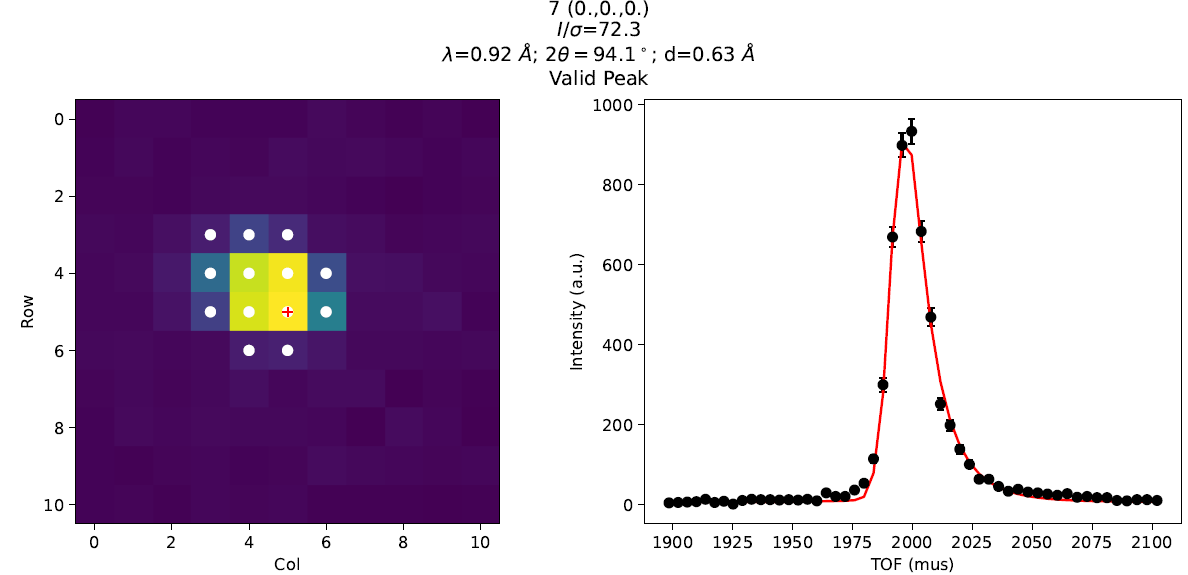IntegratePeaks1DProfile v1¶
Summary¶
Integrate single-crystal Bragg peaks in MatrixWorkspaces by fitting peaks TOF in adjacent pixels unitl I/sigma of the peak in a pixel is below a threshold. Algorithm is adapted and extendedfrom an algorithm in Gutmann, M. J. (2005). SXD2001. ISIS Facility, RAL
See Also¶
Properties¶
Name |
Direction |
Type |
Default |
Description |
|---|---|---|---|---|
InputWorkspace |
Input |
Mandatory |
A MatrixWorkspace to integrate (x-axis must be TOF). |
|
PeaksWorkspace |
Input |
IPeaksWorkspace |
Mandatory |
A PeaksWorkspace containing the peaks to integrate. |
OutputWorkspace |
Output |
IPeaksWorkspace |
Mandatory |
The output PeaksWorkspace will be a copy of the input PeaksWorkspace with the integrated intensities. |
NRows |
Input |
number |
11 |
Number of row components in the detector to use in the convolution kernel. For WISH row components correspond to pixels along a single tube. |
NCols |
Input |
number |
11 |
Number of column components in the detector to use in the convolution kernel. For WISH column components correspond to tubes. |
NBins |
Input |
number |
11 |
Number of TOF bins to use in the convolution kernel. |
GetNBinsFromBackToBackParams |
Input |
boolean |
False |
If true the number of TOF bins used in the convolution kernel will be calculated from the FWHM of the BackToBackExponential peak using parameters defined in the instrument parameters.xml file. |
NFWHM |
Input |
number |
10 |
If GetNBinsFromBackToBackParams=True then the number of TOF bins will be NFWHM x FWHM of the BackToBackExponential at the peak detector and TOF. |
CostFunction |
Input |
string |
Mandatory |
Cost funtion to minimise. Allowed values: [‘RSq’, ‘ChiSq’, ‘Poisson’] |
PeakFunction |
Input |
string |
BackToBackExponential |
Peak profile funtion to fit. Allowed values: [‘BackToBackExponential’, ‘Gaussian’] |
FixPeakParameters |
Input |
str list |
Peak parameters to fix in the fits (recommend fixing A for back-to-back exponential based functions). |
|
BackgroundFunction |
Input |
string |
FlatBackground |
Background function to fit. Allowed values: [‘FlatBackground’, ‘LinearBackground’] |
ErrorStrategy |
Input |
string |
Summation |
If Hessian then error on the integrated intensity will be determined from the partial derivatives of the cost-function wrt the parameters (this is only supported for BackToBackExponential function for which the integrated intensity is a parameter. If Summation then the error will be the quadrature sum of the individual errors. Allowed values: [‘Hessian’, ‘Summation’] |
IOverSigmaThreshold |
Input |
number |
2.5 |
Criterion to stop fitting. |
FractionalChangeDSpacing |
Input |
number |
0.02 |
Fractional change in peak centre allowed - this is a constraint in the fit. |
IntegrateIfOnEdge |
Input |
boolean |
False |
If IntegrateIfOnEdge=False then peaks on the detector edge will not be integrated. |
NRowsEdge |
Input |
number |
1 |
Shoeboxes containing detectors NRowsEdge from the detector edge are defined as on the edge. |
NColsEdge |
Input |
number |
1 |
Shoeboxes containing detectors NColsEdge from the detector edge are defined as on the edge. |
LorentzCorrection |
Input |
boolean |
True |
Correct the integrated intensity by multiplying by the Lorentz factor sin(theta)^2 / lambda^4 - do not do this if the data have already been corrected. |
OutputFile |
Input |
string |
Optional file path in which to write diagnostic plots (note this will slow the execution of algorithm). Allowed extensions: [‘.pdf’] |
|
NPixMin |
Input |
number |
0 |
Minimum number of pixels successfully fitted in a peak. |
Description¶
This is an algorithm to integrate single-crystal Bragg peaks in a MatrixWorkspace with x-units of Time-of-Flight (TOF). It is adapted and extended from an algorithm in SXD2001 [1].
The algorithm proceeds by fitting a PeakFunction and BackgroundFunction to the TOF spectrum of individual
pixels. If the fit is successful (fit converged and the ratio of intensity/sigma > IOverSigmaThreshold), then the
fit is attempted on a pixel that is adjacent to a previously successfully fit pixel. The algorithm stops
when no adjacent pixels can be successfully fitted.
The algorithm requires the user to define the number of pixels in the vicinity of a peak using the input NRows
and NCols and the TOF extent of the data to fit, which can be specified in one of two ways:
Provide
NBinsdirectly - number of TOF bins in the kernelSetting
GetNBinsFromBackToBackParams=Trueand providingNFWHM- in which caseNBinswill be NFWHM x FWHM of a BackToBackExponential peak at the center of each detector panel/bank at the middle of the spectrum.
Note to use method 2, back-to-back exponential coefficients must be defined in the Parameters.xml file for the instrument.
Optionally if OutputFile is provided a pdf can be output that shows the shoebox kernel and the data integrated along
each dimension like so

Usage¶
Example - IntegratePeaks1DProfile
from mantid.simpleapi import *
Load(Filename="SXD23767.raw", OutputWorkspace="SXD23767")
CreatePeaksWorkspace(InstrumentWorkspace="SXD23767", NumberOfPeaks=0, OutputWorkspace="peaks")
AddPeak(PeaksWorkspace="peaks", RunWorkspace="SXD23767", TOF=8303.3735339704781, DetectorID=7646)
peaks_out = IntegratePeaks1DProfile(InputWorkspace="SXD23767", PeaksWorkspace="peaks", OutputWorkspace="peaks_int",
GetNBinsFromBackToBackParams=True, NFWHM=8, CostFunction="RSq",
PeakFunction="BackToBackExponential", FixPeakParameters='A',
NRows=7, NCols=7, IOverSigmaThreshold=1,
FractionalChangeDSpacing=0.01, IntegrateIfOnEdge=True)
print(f"I/sigma = {peaks_out.getPeak(0).getIntensityOverSigma():.2f}")
Output:
I/sigma = 95.35
References¶
Categories: AlgorithmIndex | Diffraction\Reduction
Source¶
Python: IntegratePeaks1DProfile.py